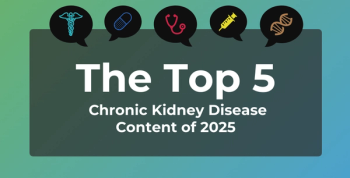
Future Treatment of Anemia in CKD: Impact of HIF Stabilizers
The impact of approval of HIF stabilizers on disease management for anemia in CKD is discussed along with potential barriers to adoption.
Transcript
Peter L. Salgo, MD: As a payer, how do you see the approval of these drugs changing the landscape in America in terms of kidney disease and in terms of treating the anemia of kidney diseases? Is this going to be a train heading down the track right at the insurance company, or has this already been discounted in your calculations? What are you going to approve?
Stanley Crittenden, MD: They will certainly change clinical management, at least for a subset of patients with anemia of CKD [chronic kidney disease]. For example, if you have the right patient profile, meaning a patient that has suboptimal responses to ESAs [erythropoietin stimulating agents] or ESA resistance, those patients will certainly benefit. As a health plan, we recognize that clinical quality is of paramount importance. We also recognize, and I mentioned this earlier, that we know that anemia of CKD seems to be undertreated and that undertreatment of anemia tends to lead to total increase in health care resource utilization because people are either crashing to the hospital, needing blood transfusions, etc.
There will be a change in clinical management. Clearly, there are patients who will benefit from this, especially given that there are known black box warnings in ESAs. For people who have underlying solid tumors, head and neck tumors, uncontrolled hypertension, or a history of strokes, these patients will certainly benefit. As a health plan, there will be a pathway to have these people on these agents if need be.
Daniel W. Coyne, MD: That brings up an interesting thing. When I think about using these drugs in the nondialysis population, when I prescribe an ESA to them, I have to warn them that those drugs can double their risk of stroke and increase other thrombotic events. None of that signal came out of the placebo-controlled trials with roxadustat. What you allude to is that I may have to have a compelling reason: “Oh, you’ve already had a stroke, so now you don’t have to go on an ESA before you can get the roxadustat.” Do you think it will come to that? What I see is that this opens the door. A lot of patients in the 9s [hemoglobin level in the range of 9 g/dL] would say, “I’d rather not have an ESA at all if that’s the risk I’m hearing,” but I can now say that there’s a new treatment that doesn’t carry those risks. Now, I can start treating these hemoglobin levels in the 9s with more confidence that I’m doing a safer job of it.
Peter L. Salgo, MD: If the risk signal is that much better, are you suggesting we just take the ESAs and consign them to the dustbin of history?
Daniel W. Coyne, MD: The improvement in cardiovascular events in the patients with incident dialysis compared to ESAs say that ESAs are going to be in the dustbin of history. However, the cardiovascular risk was about the same in prevalent patients, and there are many reasons for that: the ESAs may have already knocked off the vulnerable population, for example. All prevalent patients come from patients with incident dialysis, so if you started treating, everyone starts on dialysis with roxadustat or similar agents because they’re safer. In 5 years, everyone will be on it.
Peter L. Salgo, MD: Stanley, if I’m a patient and I’m sitting across from the brilliant Dr Coyne, and he tells me, “You can take this drug, but it increases your risk of heart disease and stroke, or you can take this drug, and both are effective on your hematocrit, which you need, but no stroke,” I shouldn’t say that it’s a no-brainer given the stroke reference here, but it’s pretty clear that I’d want this drug. Are payers going to let you skip the ESA step all together?
Stanley Crittenden, MD: If I were sitting across from the brilliant Dr Coyne, I would ask that as well. I understand the analogy, but from a populational standpoint, this would probably have to be fleshed out a bit more to help us understand what this looks like in terms of total cost of care, and we’re trying to evaluate the total patient experience, and we talked about this earlier. At this point, most payers don’t know the price or cost of what these agents will be as compared to the total cost of care of what we know now is standard of care, which is ESA therapy and iron. This is going to be determined as this drug is rolled out, and it will be based on several factors including drug pricing, but also what we talked about: the other variables that will affect patient care.
Another thing I want to mention, too, is that a lot of payers are now going toward the idea of value-based drug pricing, and it’s gained some traction in the past years. What this means is that a contract for cost of drug is tied to a health outcome, and this gets back to that idea of treating the whole person and their total health care. In exchange for some price, you’ll then agree upon a clinical outcome. You can make it be something as simple as maintaining the hemoglobin at more than 10 g/dL on this drug without having a stroke rate of X amount, and then that’s how reimbursement is decided. I’m saying all this to say that because these drugs aren’t on the market yet, there are several different strategies around making sure members get the appropriate care at the appropriate time.
Peter L. Salgo, MD: Alright. Drs Coyne and Provenzano, what more do you think you need to give the payer population—not necessarily Dr Crittenden, who is obviously brilliant and sympathetic—but everybody, to make the case for these drugs if you think it needs to be made? What kind of education?
Robert Provenzano, MD, FACP, FASN: Let me build on what Stanley said because this is a frustration, not with me but in physicians as a whole. As I mentioned, at least the data for roxadustat have been presented in the largest anemia trial that shows without a doubt in patients with incident dialysis, to Dan’s point, a 30% to 34% decrease in MACEs [major adverse cardiovascular events]. What does that mean? From a health economic perspective, it means that there’s going to be a savings from these people not having strokes or cardiovascular events. From a societal perspective, it means that they’re less likely to need rehabilitation and nursing homes. They can spend time with their family. When you start putting the pieces together, it’s going to be a hard case to deny care if the data are accurate, but data are data.
To your point, again, much like what we learned with TREAT and CHOIR, there’s a whole bunch of other questions, right? What does chronic long-term exposure to these products bring? Are there additional benefits? We have already seen that it may delay progression. From a payer perspective, delaying progression is the Holy Grail, right? From a nephrology perspective, that’s the Holy Grail. Delaying or preventing exposure to transfusions is going to have a positive benefit on transplantation. There is now evidence that there is direct positive impact on endocardial cells. There is a whole list of other things we can see on the horizon on the positive side, but let’s not forget that, on the negative side, chronic exposure, we’ve learned hard lessons in the past that we thought we knew with chronic exposure.
Peter L. Salgo, MD: We’re not going to get those data from phase 3 trials, right?
Robert Provenzano, MD, FACP, FASN: No. We’re going to need 3b trials and phase 4 trials and probably a registry. We don’t know what the FDA is going to say, but they may demand a registry. There’s a lot of stuff we still don’t know.
Newsletter
Stay ahead of policy, cost, and value—subscribe to AJMC for expert insights at the intersection of clinical care and health economics.





























































